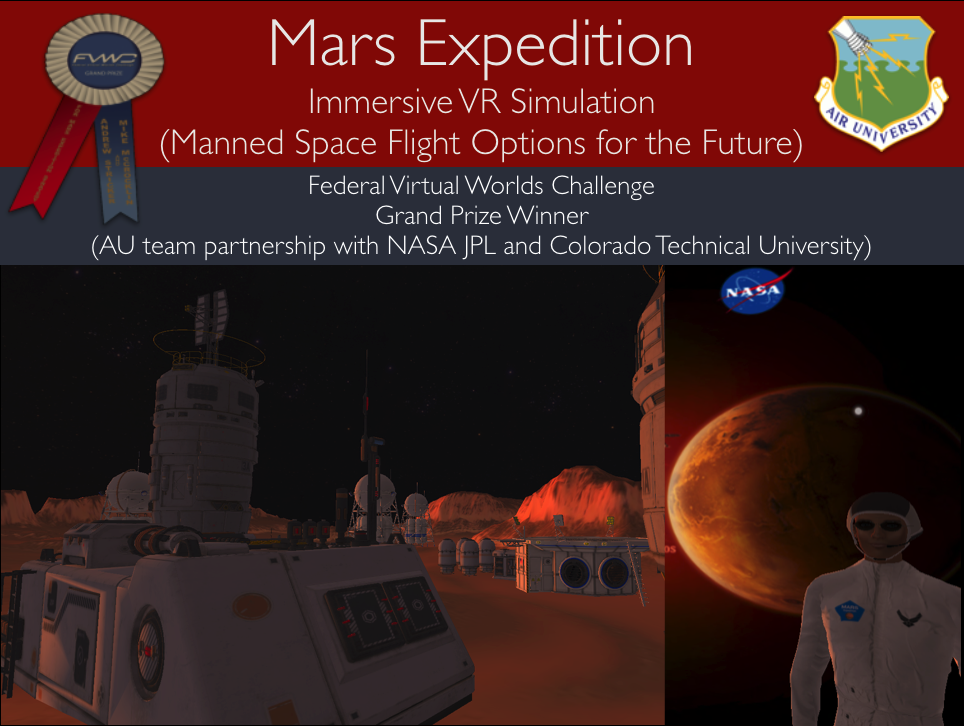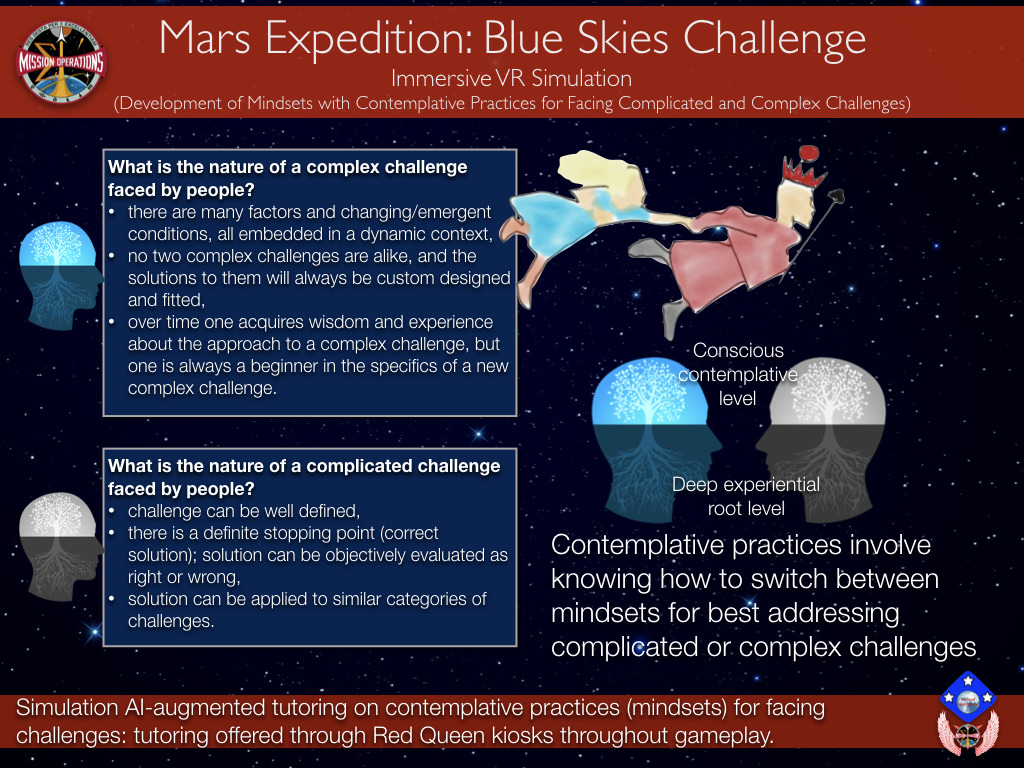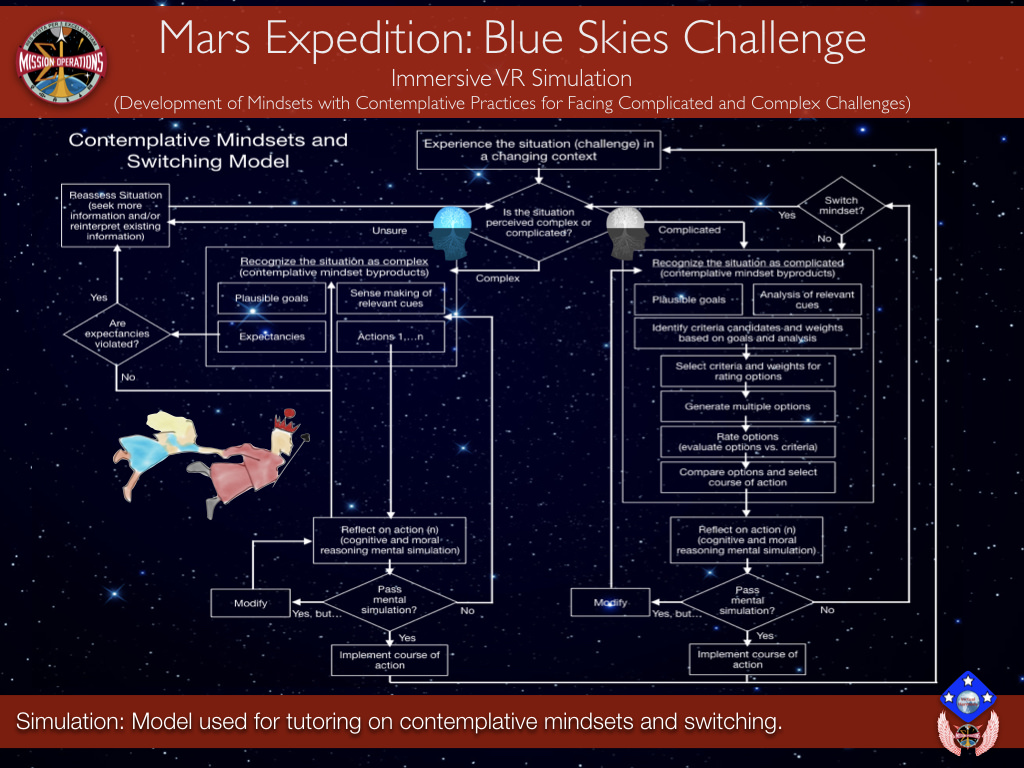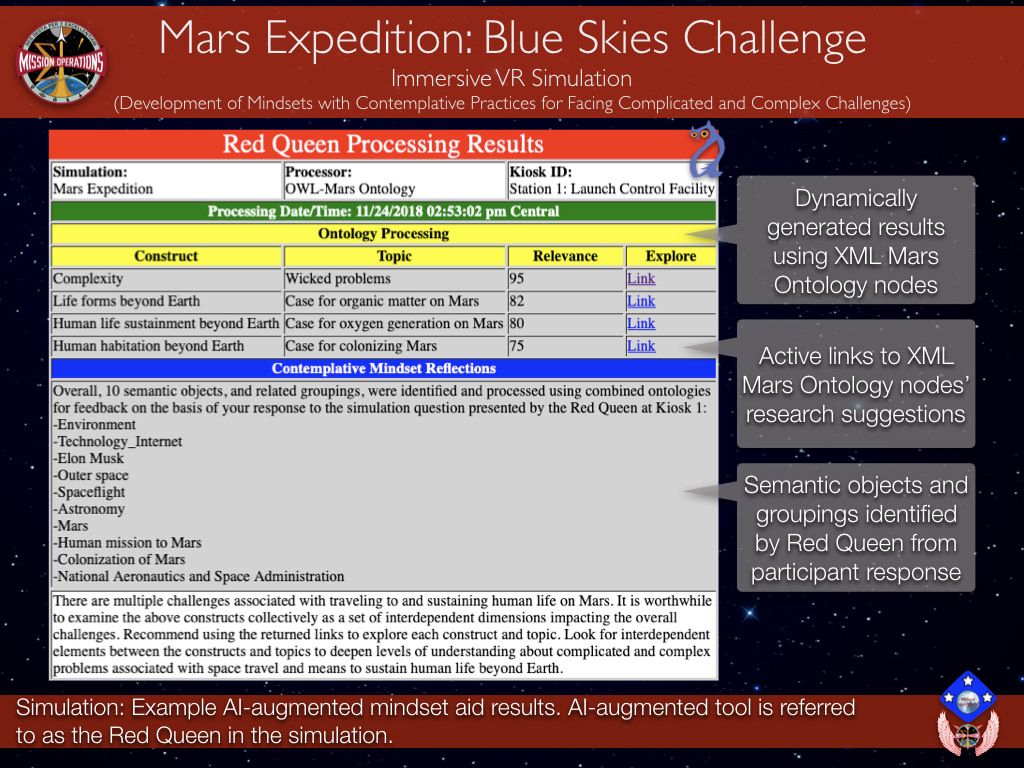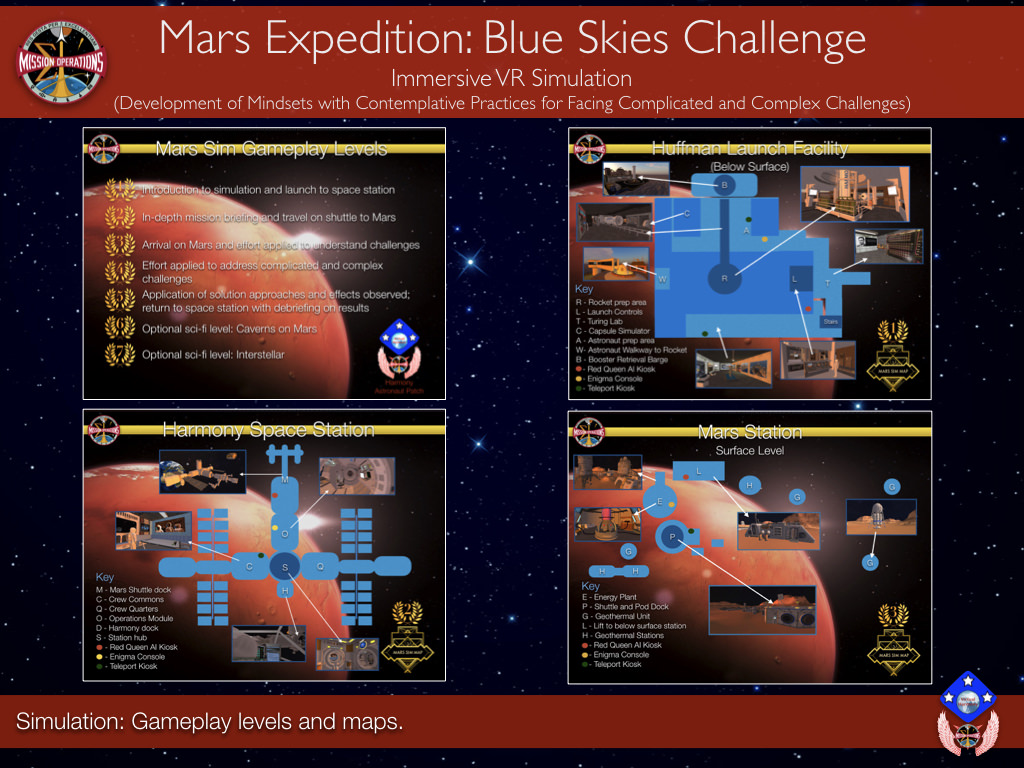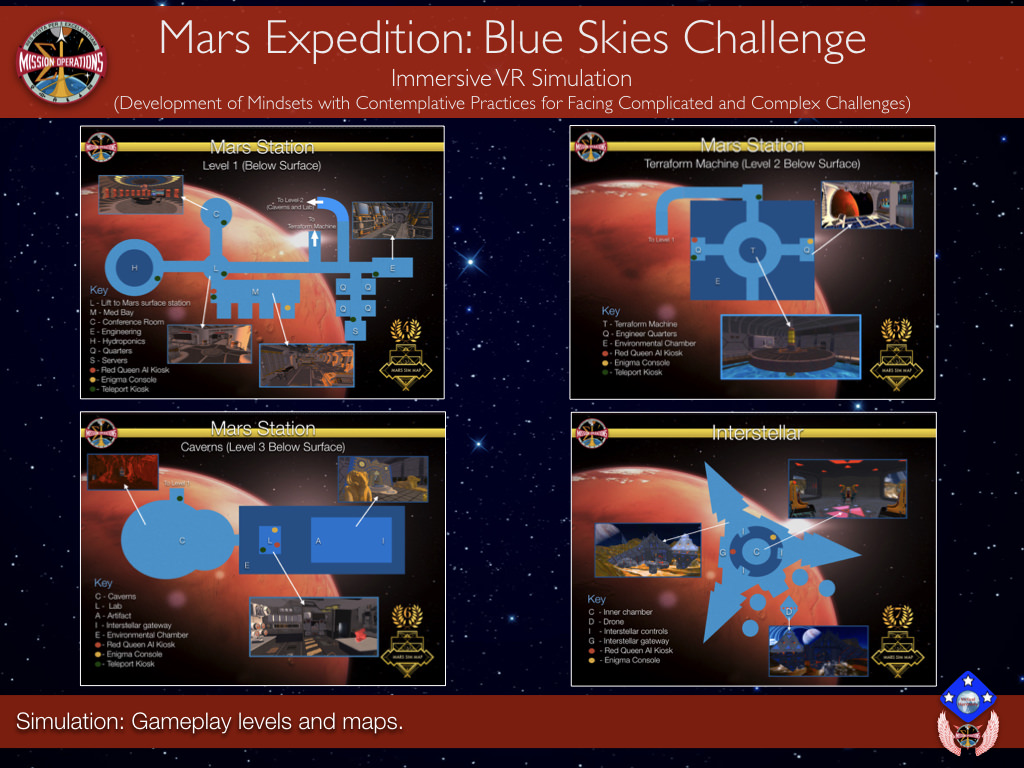Mars Expedition Info
Participants can engage with the simulation directly or as a team member to address a complex challenge associated with human space travel and challenges associated with sustaining human life on Mars. Players in the simulation respond to questions for learning about complexity, nonlinear challenges, and Mode 2 thinking as they face problems presented to them on the journey to Mars. The focus of the simulation design is on social-cognitive developmental instruction in the use of contemplative cognitive and moral reasoning practices to better discern and address complicated and complex challenges. Emphasis was placed on social-cognitive design features to promote benefits with authentic learning, social participation, and virtual embodiment of participants with real-world challenges situated in an immersive environment supporting high levels of interactivity and engagement. The intent of the design was to provide an immersive environment for the simulation where participation is deep, meaningful, and built to support interaction. Along with interacting with others, tutoring aids are provided throughout engaging activities to help participants grow in their understanding to better discern and address complicated and complex challenges using contemplative practices supporting sustained cognitive and moral reasoning.
The early prototype for the simulation was started in 2009 by a team of researchers from Air University, Colorado Technical University, University of Central Florida, and NASA Jet Propulsion Laboratory (JPL). Mars was selected as the context for the simulations’ immersive environment for tutoring on complex-problem solving due to the richness of data obtained from NASA robotic missions to Mars, since the Viking missions of the 1970s, and from extensive studies relating to human space exploration options stewarded by the Mars Exploration Program Analysis Group (MEPAG) sponsored by NASA JPL (see https://mepag.jpl.nasa.gov/index.cfm). MEPAG is an organization of approximately 100 scientists who represent collectively the Mars science community. Work on the simulation (Mars Expedition Strategy Challenge) spanned a year involving the construction and testing of interactive 3D models (e.g., space travel training devices, launch control mechanisms, rockets, and an assortment of devices supporting interactive exploration of NASA Mars studies and data) necessary to engage participants. During the simulated mission to Mars participants were introduced to the tools, procedures, and mental and physical challenges that a real future Mars mission might face. The variety and nature of challenges introduced in the simulation were obtained from NASA and National Academy of Sciences studies regarding Mars exploration.
The simulation was the grand prize winner of the inaugural Federal Virtual Worlds Challenge at the 2010 Defense GameTech Users’ Conference (see https://www.army.mil/article/37034/army_announces_federal_virtual_worlds_challenge_winners).
The simulation was also highlighted at the 2019 Virtual Worlds Best Practices in Education (see Dr. Austin Tate’s post about the Mars Expedition Simulation from the 2019 event here: http://blog.inf.ed.ac.uk/atate/2019/04/06/virtual-harmony-mars-expedition/ (Note: Dr. Austin Tate is Director of the Artificial Intelligence Applications Institute (AIAI) and holds the Personal Chair of Knowledge-Based Systems at the University of Edinburgh. He is a Fellow of the Royal Academy of Engineering (FREng), a Fellow of the Royal Society of Edinburgh (FRSE, Scotland’s National Academy), Fellow of the Association for the Advancement of AI (FAAAI), Fellow of the European Association for Artificial Intelligence (EurAI), Fellow of the British Computer Society (FBCS) and on the editorial board of a number of AI journals.)
Since 2010, researchers and developers have continued to evolve and improve upon the original Mars Expedition Strategy Challenge simulation using a collaborative design-build prototyping process (CDB) first introduced by RAND (Stricker, et.al., 2011). The team supported the use of CDB with virtual salon meetings, hosting interdisciplinary faculty and students from around the world, for soliciting and encouraging the juxtaposition of ideas to improve upon the simulation. Several improvement prospects were identified from the salon discussions and were ultimately put into the simulation using CDB:
- Moving the original simulation to the Open Simulator platform
- Making the simulation accessible to the Open Simulator community spanning several participating universities using hyper-grid technology
- Moving the simulation code to Linux virtual machines on the Cloud
- Employing a robust physics engine to simulate real-world physics in the simulation
- Using interactive mesh models for all major 3D components and tools in the simulation for improving realism and fidelity of materials supporting better shadowing and particle effects to help embed the senses, thoughts, and actions of participants in the feeling of traveling and being on Mars
- Implementing a web-based dashboard interface for viewing simulation data
- Applying Cloud Lambda services for specified code execution on task or tool demand
- Improving APIs for linking and data sharing with Open Simulator and other supporting game engines (e.g., Unity 3D)
- Introducing an AI-augmented tutoring aid, using the Web Ontology Language (OWL) to assist with coaching on contemplative patterns of thought and offering feedback specific to task performance by examining participant input regarding complex knowledge about things, groups, and relations between them
- Linking the AI-augmented tutoring aid to John Bransford’s Learning Challenge Cycle, (Bransford, et.al., 1999; 1986), for structuring and sequencing tasks presented in the simulation
- Inclusion of a Heads-Up-Display (HUD) supporting game features offered by the simulation (e.g., health scores associated with activities in space; performance assessments)
- Support for team or individual participation in the simulation; embedded team survey assessment tool added for supporting team discussions
- Improved temporal flexibility by offering sustained simulation participation options over hours, days, or even weeks
- Improving the model-based reasoning (MBR) tools with server-side data connections and processing of participant “what-if” experimentations
- Increasing the number of gameplay levels and task challenges
- Enriching the storyline of the simulation for supporting nonlinear learning pathways through gameplay levels and task challenges
- Instantiation of neural network, coded in Python, designed to be trained over time using sim players’ performance data across 7 gameplay levels (see structure example figures below)
The above list highlights the range of improvements introduced into the Mars Expedition Strategy Challenge simulation since 2010. Overall, the high-level architecture was significantly changed to improve software, engine platforms, tools, enrichments to the virtual environment, and gameplay options and quality. A PDF file is offered containing slides describing the Mars Expedition simulation using screen snapshots.
Reference
Stricker, A.G., McCrocklin, M., Calongne, C.A., & Holm, J. (2011). Situating community construction of learning ecosystems and innovations in a 3D world. International Journal of Learning and Media 3(1). Cambridge, MA: MIT Press.
